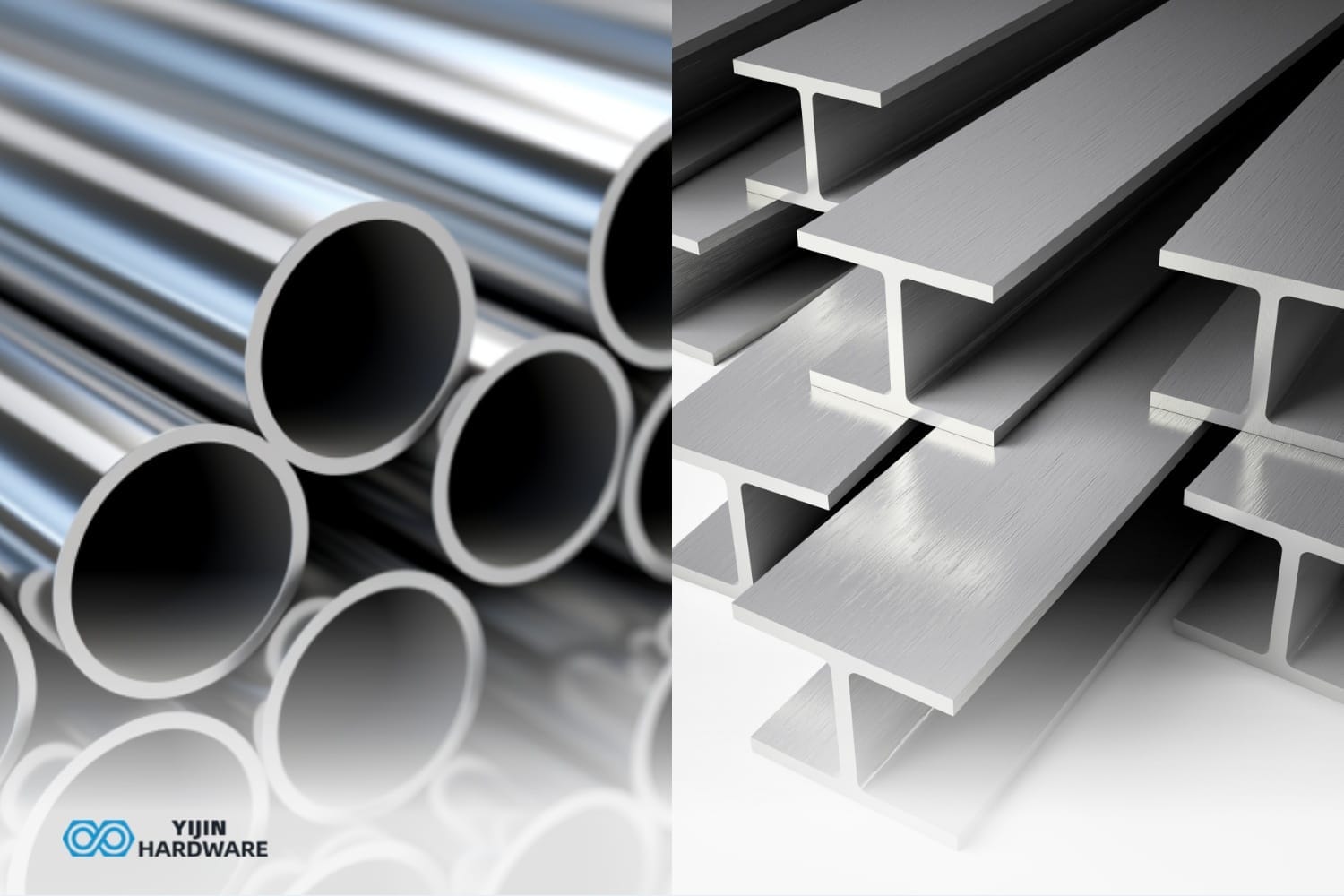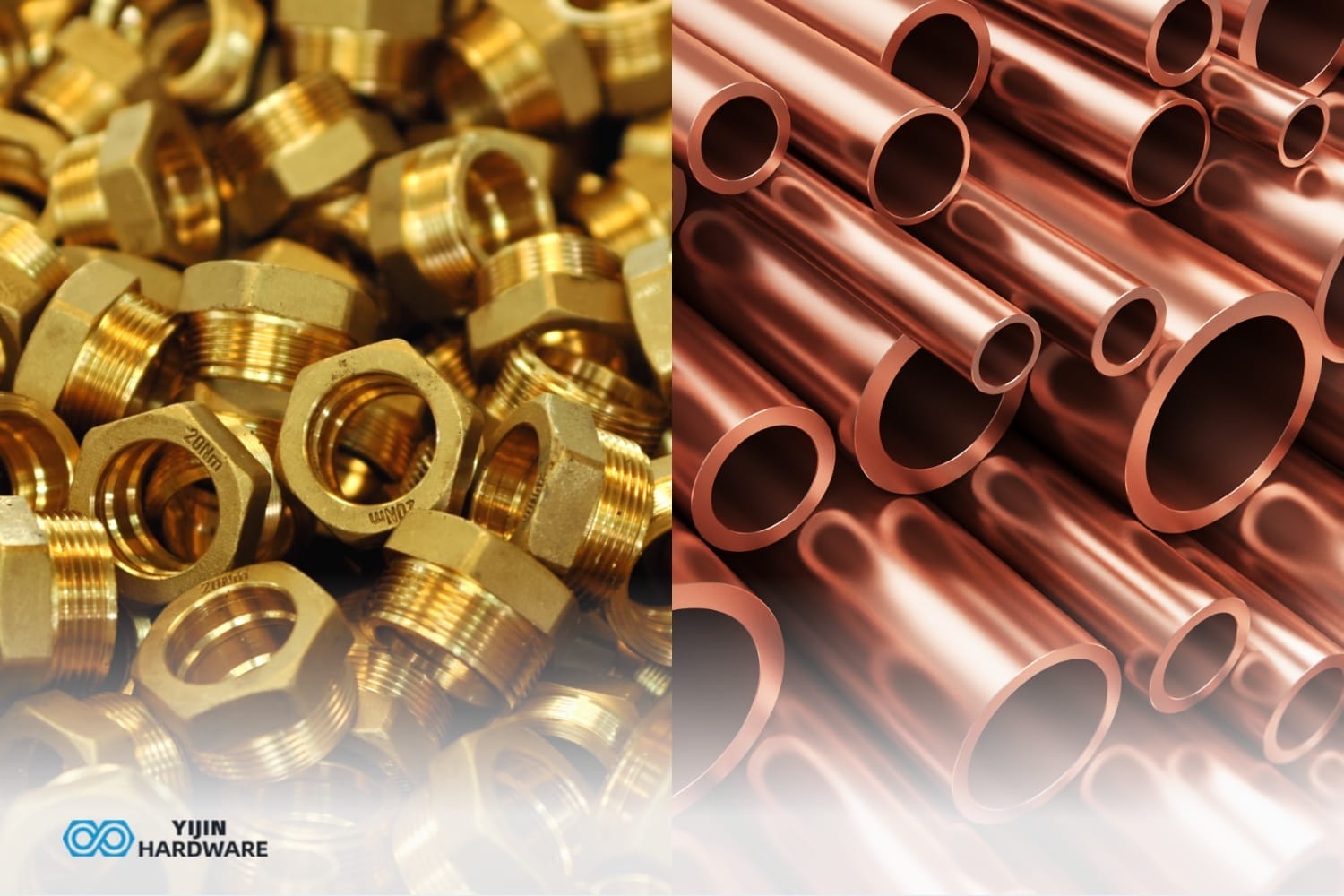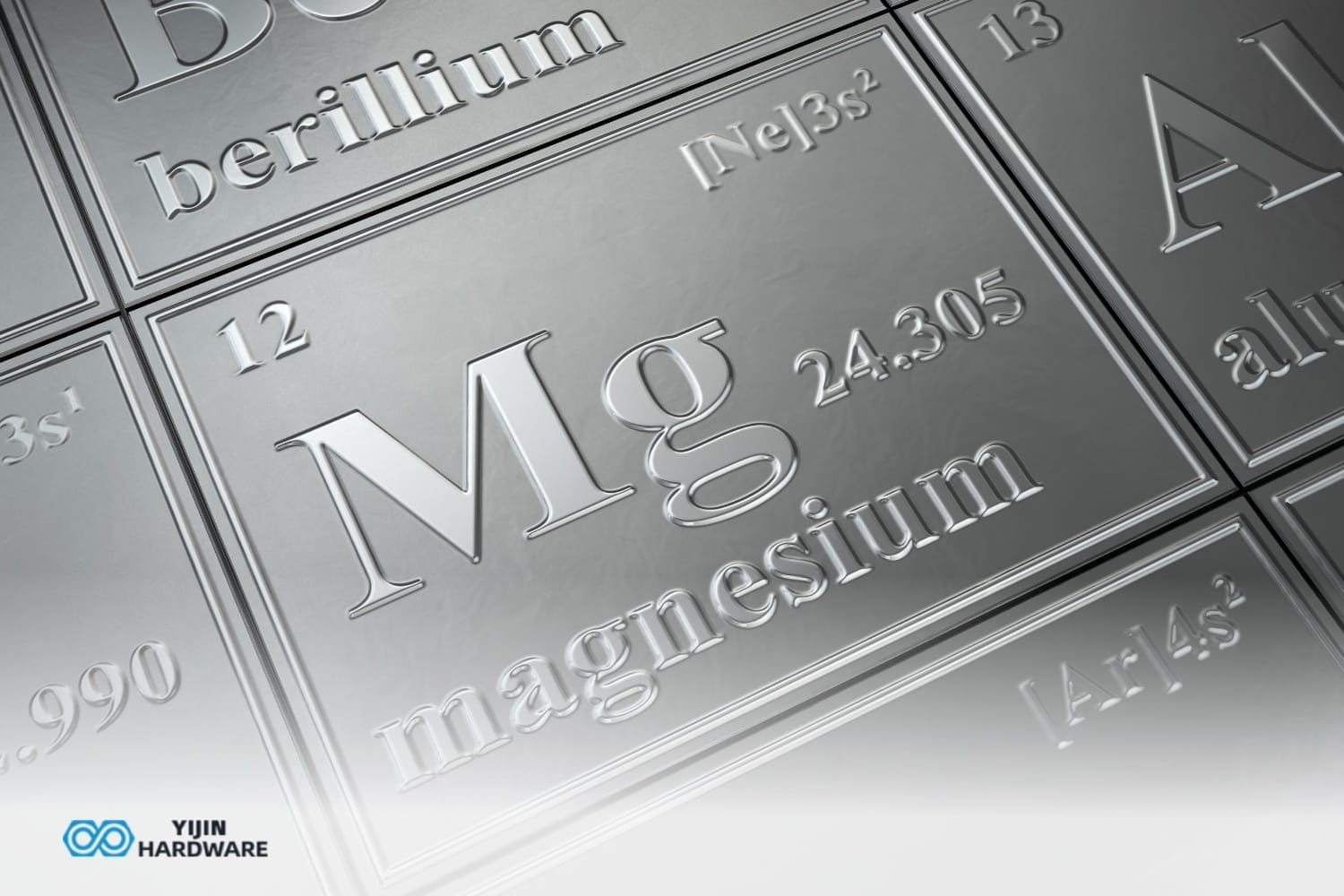The difference between Monel and Inconel is the material that makes up their composition, which also leads to a difference in their tolerance for temperature and yield strength. At Yijin Hardware, our extensive experience in precision CNC machining of these challenging materials has given us unique insights into the critical differences between Monel and Inconel alloys.
Whether you’re designing components for corrosive marine environments or demanding chemical processing equipment, understanding the distinct advantages of each alloy family is essential. We’ve written this guide to help you understand the fundamental differences between Monel and Inconel from composition to machining strategies. Let’s dive right in!
Key Takeaways
- Monel, a nickel–copper alloy, excels in corrosive, reducing environments like seawater and acids, while Inconel’s nickel–chromium formulation forms a protective oxide layer enabling robust high-temperature oxidation resistance.
- Inconel alloys typically deliver 30–50% higher yield strength and 15–40% greater tensile strength than Monel, which in turn offers superior ductility and a moderately easier machining process.
- Monel is more cost-effective for lower-temperature marine and chemical uses, whereas Inconel justifies its premium price for extreme, high-temperature, and oxidizing conditions.
What are Monel and Inconel Alloys?

Monel is a solid-solution binary alloy primarily composed of nickel (52-68%) and copper (28-34%), with small amounts of iron, manganese, carbon, and silicon. Developed in 1905 by Robert Stanley at the International Nickel Company, monel forms a single-phase structure due to the complete mutual solubility of nickel and copper.
On the other hand, inconel is an austenitic nickel-chromium superalloy containing 44-72% nickel with chromium (14-23%) as its secondary element. Inconel’s chromium content was developed in the early 1930s and creates a protective oxide layer that provides exceptional resistance to high-temperature oxidation.
What’s the Difference Between Inconel and Monel Composition?
The difference between monel and inconel includes its material composition, temperature tolerance, yield strength, and corrosion resistance. We’ve outlined the major technical differences between monel and inconel right here.
| Characteristic | Monel | Inconel |
|---|---|---|
| Composition | Ni-Cu alloy (52-68% Ni, 28-34% Cu) | Ni-Cr alloy (44-72% Ni, 14-23% Cr) |
| Primary Structure | Solid-solution binary alloy | Austenitic superalloy |
| Temperature Range | Up to 480 °C (895 °F) | Up to 982 °C (1800 °F) |
| Melting Point | 1300-1350 °C (2372-2462 °F) | 1290-1350 °C (2354-2462 °F) |
| Density | 8.8 g/cm³ | 8.2 g/cm³ |
| Yield Strength | 240-345 MPa (Monel 400)<br>515-790 MPa (K-500) | 310-517 MPa (Inconel 625)<br>550-1100 MPa (718) |
| Tensile Strength | 550-620 MPa (Monel 400)<br>790-1100 MPa (K-500) | 655-930 MPa (Inconel 625)<br>930-1375 MPa (718) |
| Corrosion Resistance | Superior in reducing environments, seawater, hydrofluoric acid | Superior in oxidizing environments, high temperatures |
| Machining Speeds | 30-50 m/min (turning)<br>20-40 m/min (milling) | 15-25 m/min (turning)<br>10-20 m/min (milling) |
| Work Hardening | Moderate but significant | Extreme — surfaces quickly become non-machinable |
| Heat Treatment | Annealing (870-980 °C)<br>Age hardening for K-500 | Solution annealing (1010-1180 °C)<br>Two-stage aging for precipitation-hardened grades |
What is Monel Made Out Of?
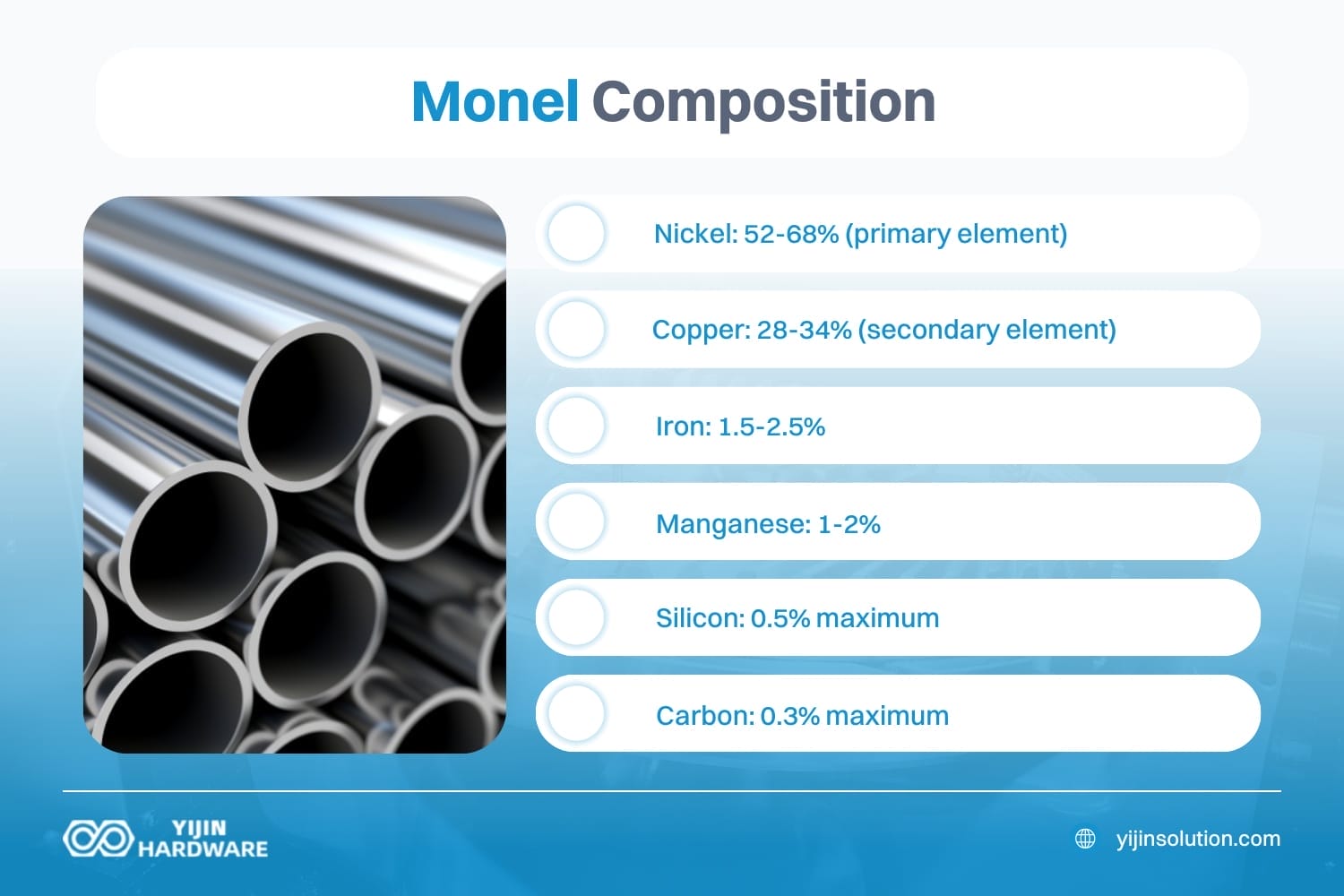
Monel is primarily made from nickel and copper, as well as in smaller degrees by iron, manganese, and silicon. Take a look at the material composition of the Monel.
- Nickel: 52-68% (primary element)
- Copper: 28-34% (secondary element)
- Iron: 1.5-2.5%
- Manganese: 1-2%
- Silicon: 0.5% maximum
- Carbon: 0.3% maximum
Monel 400 typically contains approximately 66% nickel and 31.5% copper. Monel K-500 adds aluminum and titanium to enable precipitation hardening while maintaining corrosion resistance.
Inconel Composition
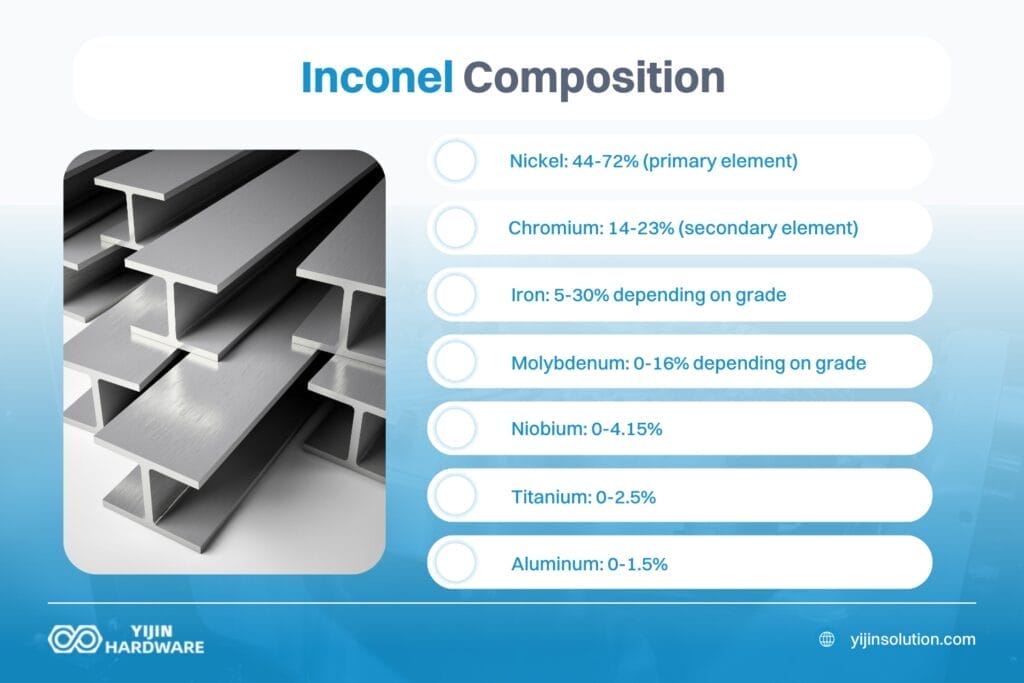
Inconel is made from nickel and chromium, as well as in smaller degrees by iron and molybdenum. Here’s a more detailed look at Inconel’s composition.
- Nickel: 44-72% (primary element)
- Chromium: 14-23% (secondary element)
- Iron: 5-30% depending on grade
- Molybdenum: 0-16% depending on grade
- Niobium: 0-4.15%
- Titanium: 0-2.5%
- Aluminum: 0-1.5%
Different Inconel grades modify element percentages for specific properties – Inconel 625 contains higher molybdenum (8-10%) for improved strength, while Inconel 718 includes more niobium (4.75-5.5%) for precipitation hardening.
How do Monel and Inconel Compare in Corrosion Resistance?
Monel offers outstanding corrosion resistance in reducing environments, excelling in seawater and acid (especially hydrofluoric and sulfuric) conditions.
In contrast, Inconel’s high chromium content enables it to form a protective oxide layer at elevated temperatures, providing excellent resistance in oxidizing, combusting, and carburizing environments, with Inconel 625 additionally performing well in hot seawater applications.
Monel Corrosion Resistance
Monel excels in reducing environments, with excellent corrosion resistance to a variety of corrosive conditions. It offers superior resistance to salt spray and marine environments, making it ideal for seawater applications where many other alloys would rapidly deteriorate.
One of Monel’s most valuable properties is its exceptional resistance to hydrofluoric acid across all concentrations. This is a rare characteristic among engineering materials. The alloy also demonstrates strong resistance to sulfuric acid under reducing conditions, excellent performance across various concentrations of alkalis, and outstanding resistance to freshwater with minimal deterioration over extended service periods.
Inconel Corrosion Resistance
Inconel demonstrates exceptional resistance to oxidizing environments, delivering superior performance due to its high chromium content. When exposed to elevated temperatures, Inconel forms a protective oxide layer that prevents further attack and maintains structural integrity.
This makes it particularly valuable in hot gases, where it resists deterioration in combustion environments that would quickly degrade standard alloys. Inconel also maintains integrity in carburizing atmospheres where carbon diffusion occurs, protecting components from embrittlement.
While generally not the first choice for marine applications, Inconel 625 specifically offers good resistance to seawater environments when high-temperature resistance is also required.
What Temperature Ranges Can Monel and Inconel Withstand?
Monel can withstand temperatures between -250℃ and 480℃, while Inconel can tolerate temperatures between -250℃ and 982℃. While several factors can alter this safe temperature range, Monel and Inconel are both extremely temperature resilient metal alloys.
Monel Temperature Performance
Monel demonstrates impressive versatility across a wide temperature spectrum, functioning effectively from cryogenic conditions as low as -250 °C all the way to moderate elevated temperatures. Its maximum operational temperature reaches approximately 480 °C (895 °F), beyond which it begins to experience significant degradation in mechanical properties and oxidation resistance.
Despite this operational limit, Monel maintains its impressive melting range of 1300-1350 °C (2372-2462 °F), comparable to many other high-performance alloys. This temperature profile makes Monel suitable for applications involving cryogenic exposure or moderate heat, but limits its use in very high-temperature environments.
Inconel Temperature Performance
Inconel exhibits exceptional thermal capability, functioning reliably from cryogenic conditions around -250 °C up to remarkably high temperatures of 982 °C (1800 °F), depending on the specific grade. This superior high-temperature performance significantly exceeds Monel’s capabilities while maintaining a similar melting range of 1290-1350 °C (2354-2462 °F). Inconel’s exceptional high-temperature performance derives from its stable, protective oxide layer and microstructure that resists creep through various strengthening mechanisms, including solid solution strengthening, precipitation hardening, and carbide formation.
This extraordinary temperature resistance explains why Inconel remains the material of choice for the most demanding thermal applications in aerospace, industrial furnaces, and gas turbines.
How do the Mechanical Properties of Monel and Inconel Compare?
Inconel alloys generally demonstrate 30-50% higher yield strength and 15-40% greater tensile strength than Monel. Inconel maintains strength integrity up to 982°C, while Monel begins significant strength degradation above 480 °C.
| Property | Monel 400 | Monel K-500 | Inconel 625 | Inconel 718 |
|---|---|---|---|---|
| Yield Strength (MPa) | 193 to 345 | 555 to 790 | 310 to 517 | 550 to 100 |
| Tensile Strength (MPa) | 650 to 790 | 1000 to 1100 | 655 to 837 | 930 to 1375 |
| Elongation (%) | 35 to 50% | 20-30% | 45% | 12 to 22% |
| Hardness (Rockwell) | 65 to 70 HRB | 27 to 35 HRC | 95 HRB | 36 to 42 HRC |
| Density (g/cm³) | 8.8 | 8.44 | 8.44 | 8.19 |
Monel typically shows better ductility, with Monel 400 exhibiting 35 to 50% elongation compared to 45% for Inconel 625. Both alloys work-harden rapidly during forming operations.
Density differences make Inconel approximately 7% lighter than Monel for identical components, significant in weight-sensitive applications like aerospace.
What are the Best Applications for Monel Alloys?
The best applications for Monel alloys are marine, chemical processing, and certain specialized applications. We’ve outlined the parts and components where using Monel is the optimal choice.
Marine and Offshore Applications
- Pump shafts and impellers: Resistant to erosion-corrosion in flowing seawater
- Valve components: Maintaining integrity despite saltwater exposure
- Propeller shafts: Combining strength with corrosion resistance
- Seawater piping systems: Long-term reliability in corrosive conditions
- Heat exchangers: Handling seawater cooling with minimal deterioration
Chemical Processing Equipment
- Hydrofluoric acid handling equipment: One of few materials resistant to all concentrations
- Alkylation unit components: Particularly in direct contact with concentrated hydrofluoric acid
- Sulfuric acid handling: Under reducing conditions
Specialized Applications
- Musical instruments: Valve pistons in high-quality brass instruments
- Non-magnetic applications: For environments requiring zero magnetic permeability
- Cryogenic equipment: Maintaining toughness at extremely low temperatures
How do CNC Machining Challenges Compare Between Monel and Inconel?
Both alloys share several machining challenges, including rapid work hardening, high tool wear rates, and poor chip breaking. However, they differ in severity and approach:
| Parameter | Monel 400 | Inconel 625 |
|---|---|---|
| Turning Speed | 70 to 100 m/min | 25 to 30 m/min |
| Turning Feed | 0.2 to 0.5 mm/rev | 0.13 to 0.25 mm/rev |
| Milling Speed | 20 to 50 m/min | 15 to 20 m/min |
| Milling Feed | 0.13 to 0.20 mm/tooth | 0.13 to 0.20 mm/tooth |
| Drilling Speed | 10 to 20 m/min | 5 to 15 m/min |
| Drilling Feed | 0.05 to 0.25 mm/rev | 0.05 to 0.20 mm/rev |
| Tool Material | Carbide (K20-K30) | Carbide (K10-K20) or Ceramic |
| Coolant | Water-based soluble oil | High-pressure water-soluble directed coolant |
Inconel creates more severe machining challenges with extreme work hardening rates, requiring 50-70% lower cutting speeds than mild steel. Monel is somewhat more machinable, but still requires careful parameter selection and rigid setups.
How do Monel and Inconel Compare in Cost and Availability?
Both alloys command premium pricing, with Inconel typically 15-30% more expensive than equivalent Monel grades. Factors affecting cost include raw material fluctuations (particularly nickel and chromium), manufacturing complexity requiring vacuum melting, and limited production volumes.
While the initial investment exceeds conventional materials, total lifecycle cost often proves economically advantageous in demanding applications where standard materials would rapidly deteriorate.
How to Choose Between Monel and Inconel for Your Project?
Take a look at the requirements of your component, including its temperature requirements, the environment, and how much chemical exposure your project’s components will have. From there, you can make an educated choice on whether Monel or Inconel is better for your project.
| Selection Criteria | Choose Monel When… | Choose Inconel When… |
|---|---|---|
| Temperature Requirements | Operating temperatures below 480 °C | Operating temperatures above 480 °C |
| Environmental Conditions | Reducing environments (non-oxidizing) | Oxidizing environments |
| Marine Applications | Standard seawater exposure | Marine applications with high temperatures |
| Strength Requirements | Moderate strength is sufficient | Maximum strength is required |
| Chemical Exposure | Hydrofluoric acid is present | Oxidizing acids or hot gases are present |
| Cost Considerations | Lower initial cost is preferred | Performance outweighs cost concerns |
| Machining Priorities | Slightly better machinability is valued | Maximum high-temperature performance is essential |
Choosing the right material for your CNC machining is only outweighed by the manufacturer you work with. Yijin Hardware is your reliable and experienced manufacturer that has worked with Monel and Inconel materials to produce exceptional components. Get a free quote for your custom CNC and sheet metal fabrication today.
Monel vs. Inconel FAQs
Is Monel better than Inconel?
No, Monel is not inherently better than Inconel. It does excel in applications requiring resistance to seawater and reducing media, such as hydrofluoric acid, due to its copper content. In contrast, Inconel is superior in high-temperature environments and offers higher oxidation resistance, making it ideal for applications like aerospace and chemical processing.
What is the difference between Inconel 600 and Monel 400?
Inconel 600 is a nickel-chromium alloy with excellent high-temperature resistance and oxidation properties, making it suitable for applications like heat treatment equipment and nuclear industries. Monel 400, a nickel-copper alloy, is renowned for its corrosion resistance in seawater and chemical environments, commonly used in marine and chemical processing industries.
Why is Inconel so expensive?
Inconel is expensive due to its high nickel and chromium content, which are costly metals, and the complex manufacturing processes required to produce it, including advanced melting and forging techniques. Additionally, the high melting point of Inconel, its high strength, and corrosive environments justifies its cost for critical applications in industries like aerospace and chemical processing.
Back to Top: Monel vs Inconel CNC Material | What is the Difference?


